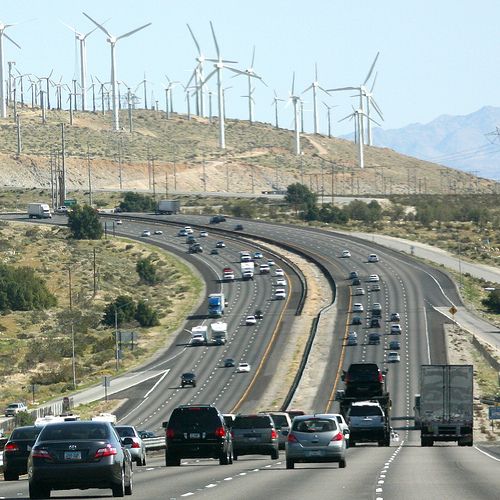I went down to Washington, D.C. on Tuesday for “Auto Communities and the Next Economy: Partnerships in Innovation,” a conference hosted jointly by the Brookings Institution Metropolitan Policy Program, the White House Council on Automotive Communities and Workers, the United States Department of Labor and the Funders’ Network for Smart Growth and Livable Communities. Businesspeople, community leaders, foundations, advocacy groups and public officials gathered to hear presentations and panel discussions featuring a prominent bunch of experts and leaders, including Hilda Solis, the Secretary of the Department of Labor, Lawrence Summers, the Director of the National Economic Council, Senator Carl Levin and the ubiquitous Bruce Katz. The event’s focus was on identifying and forging partnerships among stakeholders in regions affected by the auto industry’s decline, devising strategies for a “new” economy focused on green tech and exports and forming policy recommendations to facilitate the above.
Naturally, the conference focused largely on the metropolitan areas of the Great Lakes region, especially those in Michigan, and communities long affected by plant closures and economic decline over the past 50 years. Fortunately, presenters spent very little time focusing on the past; for the most part, the gathering – which Katz described as “federalist” – focused on solutions, and the partnerships driving them.
The big news of the day was the announcement that the government is planning to invest $800 million into the cleanup and repurposing of 90 industrial sites formerly owned by GM, rehabbing them for new uses. Ed Montgomery, director of Recovery for Auto Communities and Workers, called it an “unprecedented investment”; Michigan Governor Jennifer Granholm – whose lively speech about economic progress in Michigan was one of the day’s highlights – was particularly excited (she immediately invited everyone in the room to come do business on the rehabbed sites). The government, not surprisingly, defended its ongoing efforts to help the region and in particular praised the bailout of the auto industry, repeatedly saying that the decision had all but saved the nation from disaster.
There was a special panel on Detroit that brought together, among others, Dave Bing, Detroit’s mayor, Senator Debbie Stabenow, Carol Goss of the Skillman Foundation and Toni Griffin, a planner newly hired by Detroit to repurpose the land in a city that once had 2 million people and now has around 850,000. There was terrific optimism surrounding Griffin’s efforts in particular; at one point, seeming flustered, she had to remind the rest of the panel that rehabbing the city was “our job,” not just her job. She said it will take 12-18 months to form a concrete plan for land reuse. And no, she laughed, it will not involve just creating hundreds of urban farms.
For the most part, the tone was optimistic, the ideas solid and together attendees presented many individual examples of economic success. But it took just a few words from congressman John Conyers, Jr. (D-MI) to sum up the main issue with the event. “We might,” he said, “be accused of talking to ourselves.” The final panel, “Discussion with Members of Congress,” contained three Democrats who essentially all said the same thing; conservatives, and perhaps the right in general, didn’t have a voice in the overall discussion. This was substantiated by the prevailing political philosophies expressed: Protectionism was the rule of the day; the troubles of the auto industry were repeatedly blamed on “state-run capitalism” in countries like China. And in a room full of union representatives, including UAW’s Ronald Gettelfinger, no one seemed interested in talking about the many issues surrounding unions or the role of unions in economic recovery. Whether you’re pro-labor or against, it needs to be a significant part of any policy discussion. And while Katz said at the start that there would be “no return to normal” for the auto communities, it was unclear whether this message got through. Some people explicitly said that auto jobs are not coming back; others explicitly said they would. While everyone seemingly agreed that clean energy should be the cornerstone of a new economy, there seemed to be a sense of confusion and disagreement about the automotive industry in particular and its role in economic resurgence.
Still, there were many inspiring moments. The concept of regional cooperation seems to be catching on among many different players. Speakers demonstrated concrete examples of interagency cooperation, especially among government cabinets (the EPA, for example, was instrumental in getting the GM site cleanup money). There are many new companies launching in formerly distressed communities. Foundations and government are giving huge amounts of money, right now, to exciting endeavors; Solis in particular issued a plea to encourage people to find out about existing funding opportunities, especially for jobs training, and take advantage of them.
But the most compelling moment of the day, in my view, was a simple slideshow from Luis Urbinas, president of the Ford Foundation. In a short talk about Ford’s significant investments in the Detroit area, he showed slides of the South Bronx in the 1970s – a blighted, largely abandoned place that people thought was lost for good. And then he clicked to images of placid streets and bustling boulevards – today’s South Bronx, which he described as a “sustainable low-income community.” Anyone who’s seen images from Detroit’s troubled neighborhoods might have trouble imagining such a transformation happening there, but it was an against-all-odds change that happened in the Bronx, and if yesterday’s summit revealed one thing, it’s that several hundred extremely powerful people are working very hard to transform the urban landscape of the Rust Belt.




_600_350_80_s_c1.jpg)


_600_350_80_s_c1.jpg)
_600_350_80_s_c1.JPEG)







